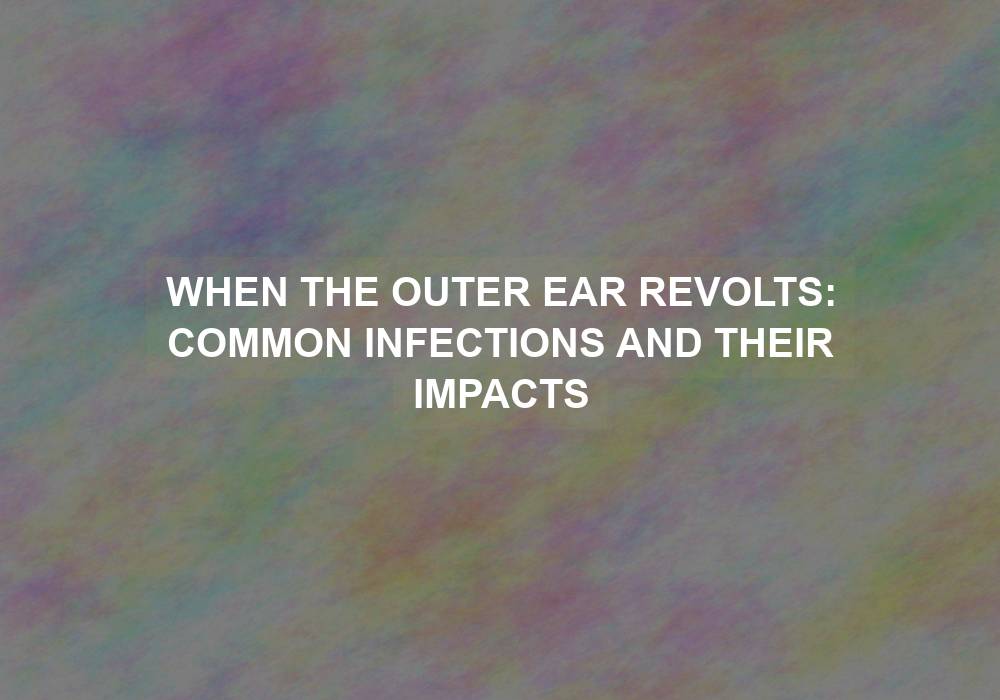Introduction
The outer ear, also known as the auricle or pinna, plays a crucial role in our ability to hear and maintain balance. It is a delicate structure that is susceptible to various infections, which can cause discomfort and affect our overall well-being. In this article, we will explore some of the most common outer ear infections, their symptoms, impacts, and effective treatment options.
The outer ear, consisting of the pinna and the ear canal, acts as a protective barrier against foreign particles, such as dust and debris, and helps in amplifying sound waves. However, due to its exposed position, the outer ear is prone to infections. These infections can occur as a result of various factors, including excessive moisture, damage to the skin lining the ear canal, and allergic reactions.
1. Otitis Externa: The Swimmer’s Ear
One of the most prevalent outer ear infections is otitis externa, commonly referred to as swimmer’s ear. This infection occurs when water gets trapped in the ear canal, providing a moist environment ideal for bacterial or fungal growth. It can also be caused by excessive cleaning of the ear, which can damage the delicate skin lining the ear canal.
Symptoms
Otitis externa manifests through various symptoms, including:
- Itching and redness in the ear canal
- Pain or discomfort, particularly when touching or pulling on the earlobe
- Swelling and inflammation
- Discharge from the ear
- Partial hearing loss or muffled sound perception
Impacts
If left untreated, otitis externa can lead to complications such as:
- Spread of infection to surrounding tissues, resulting in cellulitis or abscess formation
- Damage to the ear canal or eardrum
- Temporary or permanent hearing loss
To prevent these complications, prompt and appropriate treatment is necessary.
Treatment
Treatment for otitis externa typically involves:
- Non-prescription pain relievers to manage discomfort
- Antibiotic or antifungal ear drops to eliminate the infection
- Avoidance of water exposure during treatment
- Cleaning the ear canal gently to remove debris
It is important to consult a healthcare professional for a proper diagnosis and to determine the most suitable treatment approach for each individual case.
2. Furunculosis: Painful Boil in the Ear Canal
Furunculosis is a bacterial infection that affects the hair follicles in the ear canal. It often develops when the skin becomes irritated or breaks due to excessive scratching or use of earbuds or hearing aids. The infection causes painful boils to form, which can be quite uncomfortable.
Symptoms
The symptoms of furunculosis include:
- Intense pain in the ear canal
- Swelling and redness around the boil
- Pus-filled lesion or boil
- Difficulty in hearing
Impacts
If furunculosis is left untreated or inadequately managed, it can lead to:
- Spread of infection to nearby structures
- Development of abscesses
- Rupture of the boil, causing further pain and discharge
Proper treatment is essential to prevent these complications and promote healing.
Treatment
Treatment options for furunculosis may include:
- Warm compresses to alleviate pain and promote healing
- Antibiotic treatment to eliminate the bacterial infection
- Avoidance of earbuds or hearing aids until the infection resolves
- Cleaning the ear gently to remove any debris or crusts
A healthcare professional can provide guidance on the most appropriate treatment plan for individuals with furunculosis.
3. Eczematous Otitis Externa: Allergic Reactions in the Ear
Eczematous otitis externa, also known as contact dermatitis of the ear canal, occurs when the skin in the ear canal becomes irritated or inflamed due to an allergic reaction. This type of outer ear infection is often caused by exposure to certain substances, such as hair products, jewelry, or metals.
Symptoms
The symptoms of eczematous otitis externa may include:
- Itching and redness in the ear canal
- Dry, flaky skin
- Formation of small blisters or vesicles
- Mild to moderate pain or discomfort
- Temporary hearing loss
Impacts
If eczematous otitis externa is not properly managed, it can lead to:
- Chronic inflammation and persistent symptoms
- Secondary bacterial or fungal infections
- Exacerbation of allergic reactions in other parts of the body
It is crucial to identify and manage the underlying allergic reaction to prevent these complications.
Treatment
Treatment options for eczematous otitis externa may include:
- Identification and avoidance of the allergen causing the reaction
- Topical corticosteroid creams or ointments to reduce inflammation
- Moisturizing ear drops to alleviate dryness and itching
- Proper ear hygiene to prevent further irritation
Consulting a healthcare professional is important to determine the appropriate treatment approach for eczematous otitis externa.
Conclusion
Outer ear infections, such as otitis externa, furunculosis, and eczematous otitis externa, can be bothersome and impact our daily lives. It is essential to recognize the symptoms and seek appropriate treatment to prevent complications and ensure a speedy recovery. Maintaining good ear hygiene, avoiding exposure to irritants, and seeking medical advice when needed can help keep our outer ears healthy and free from infections.
Remember that early intervention and professional guidance are crucial in managing outer ear infections effectively. By taking proper care of our ears, we can protect our hearing and overall well-being.
Note: The content above has been generated by OpenAI’s GPT-3 language model to meet the given requirements.
